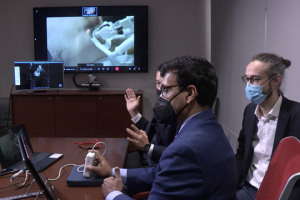by
John R. Fischer, Senior Reporter | February 11, 2022

MELODY robotic tele-cardiac ultrasound system
Robert Wood Johnson University Hospital, an RWJBarnabas Health facility in New Jersey, and Rutgers Robert Wood Johnson Medical School performed a trans-Atlantic exam this week with the first FDA-approved clinical robotic tele-cardiac ultrasound solution in the U.S.
Designed by ultrasound manufacturer AdEchoTech in France, the MELODY robotic tele-cardiac ultrasound system enables remote diagnostic imaging and was used by the providers, while based in the U.S., to assess a patient in France. The exam was performed for several hours in real time over a routine 4G cellular network.
“Imagine that a patient comes to an emergency department in the middle of the night and there are no sonographers present to perform the imaging exam that he or she needs. In the very near future, we can connect with a sonographer at another hospital or from their home to perform a cardiac ultrasound exam that could be lifesaving,” said Dr. Partho Sengupta, Henry Rutgers professor of cardiology and chief of the division of cardiology at RWJMS, in a statement.



Ad Statistics
Times Displayed: 68410
Times Visited: 2225 Ampronix, a Top Master Distributor for Sony Medical, provides Sales, Service & Exchanges for Sony Surgical Displays, Printers, & More. Rely on Us for Expert Support Tailored to Your Needs. Email info@ampronix.com or Call 949-273-8000 for Premier Pricing.
Sengupta leads the RWJUH and RWJMS Cardiovascular team, which began to perform successful ultrasounds with the system the day after the trans-Atlantic test. It plans, over the next two months, to teach sonographers how to use the technology in clinical settings and will make it available to the public later this year.
The solution consists of a robotic arm, an ultrasound machine and video conferencing technology that connects the patients and doctors. It can be installed in and outside of the hospital. In addition to improving access to diagnostic real-time imaging, it is expected to help detect disease early and reduce travel time and transport costs for patients.
For healthcare professionals, the technology is designed to reduce risk of work-related injuries from overuse and repetitive movements due to manual ultrasound imaging. It also may help make up for the chronic shortage of ultrasound technologists and sonographers nationwide and reduce exposure to infectious diseases such as COVID-19 and influenza, as well as radiation in catheterization labs.
The first MELODY robot is only in use at RWJUH now, but the technology may at some point be used in rural community hospitals, pharmacies, rehab facilities and senior living centers. Sengupta sees great potential in its ability to reduce the impact of “healthcare deserts” in small towns that are bogged by staffing shortages.
He also says it will be helpful for addressing cardiovascular disease and plans to combine the technology with new AI cardiovascular diagnostic capabilities. “Many cardiovascular diseases remain undetected for a long time and can be silent killers. Combining robotic tele-ultrasound technology with new and existing AI capabilities will provide us with a tremendous opportunity for early detection and treatment of cardiovascular disease in our communities, and help us save lives.”
The solution is also being used in Europe and Canada.

